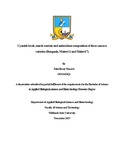Please use this identifier to cite or link to this item:
https://cris.library.msu.ac.zw//handle/11408/3048| Title: | Cyanide levels, starch content and antioxidant compositionof three cassava varieties (Benguela, Malawi 1 and Malawi 7) | Authors: | Masawi, Tsitsi Bessie | Keywords: | Cassava Manihot esculenta Drought resistant crop |
Issue Date: | 2017 | Publisher: | Midlands State University | Abstract: | Cassava (Manihot esculenta) is a drought resistant crop that can potentially contribute to food security through diversification of the staple diet in Zimbabwe. A major hindrance to its adoption as a major food item is its perceived toxicity because it contains a cyanogenic glycoside, which can be hydrolyzed into hydrogen cyanide, HCN, and there is also lack of its nutritional benefits. A comparative study of three cassava varieties (Benguela, Malawi 1 and Malawi 7) grown in Zimbabwe, was done to: characterize their nutrient status (i.e. starch content), antioxidant properties, and dry matter content, determine cyanide concentration, and determine the effect of processing (boiling and drying) on cyanide concentration. Cyanide concentration differed significantly among varieties (ANOVA, p = 0.00) and between plant parts (ANOVA, p = 0.00). Cyanide concentration was highest in Malawi 7 (69 ± 4.00 and 134 ± 6.35 mg kg-1, in leaves and roots, respectively) followed by Benguela with a cyanide concentration of 65 ± 4.21 and 131 ± 3.48 mg kg-1, and Malawi 1 with a concentration of 63 ± 3.30 and 125 ± 4.99 mg kg-1, in roots and leaves, respectively. Boiling reduced cyanide concentration by an average of 66% to 24 ± 3.63 mg kg-1 in Benguela, 20 ± 2.64 mg kg-1 in Malawi 1 and 23 ± 3.35 mg kg-1 in Malawi 7. Drying had a similar effect, reducing cyanide concentration by about 59% to 25 ± 4.21 mg kg-1 in Benguela, 29 ± 3.88 mg kg-1 in Malawi 1 and 27 ± 4.12 mg kg-1 in Malawi 7. The HCN concentrations for all the three varieties before processing were within the WHO recommended level (10 mg kg-1 body weight). A 200 g average cassava meal after processing contains 4.5 mg kg-1 of HCN, which lies within the acceptable WHO limits and much lower than the body toxic level. Starch content varied significantly among the three varieties (ANOVA, p = 0.00), being 19 % in Benguela followed by Malawi 7 with 16% and Malawi 1 with 15%). Dried mass also varied significantly among the three varieties (ANOVA, p = 0.00). It was highest in Benguela (44%) followed by Malawi 7 (40%) and Malawi 1 (38%). Cassava leaves of all three varieties contained the following antioxidants: alkaloids, flavones and phenolic flavonoids, meaning that cassava is not only a good source of calories but also antioxidants, which are well sought after by consumers. HCN content in the three varieties, even before processing, was within the WHO recommended safe level therefore the varieties can be safely adopted for consumption. The best variety of choice in terms of HCN content would be Malawi 1 with the least HCN content. Benguela would also be the best choice in terms of producing high yield with higher starch and dry matter. In light of these results, I recommend that consumers prepare their boiling. Further similar studies should be carried out focusing on other varieties in Zimbabwe. | URI: | http://hdl.handle.net/11408/3048 |
| Appears in Collections: | Bachelor Of Science In Applied Biosciences And Biotechnology Honours Degree |
Files in This Item:
| File | Description | Size | Format | |
|---|---|---|---|---|
| Final Draft Tsitsi Library_20 Feb.pdf | Full Text | 1.6 MB | Adobe PDF |  View/Open |
Page view(s)
184
checked on Dec 24, 2025
Download(s)
50
checked on Dec 24, 2025
Google ScholarTM
Check
Items in MSUIR are protected by copyright, with all rights reserved, unless otherwise indicated.



